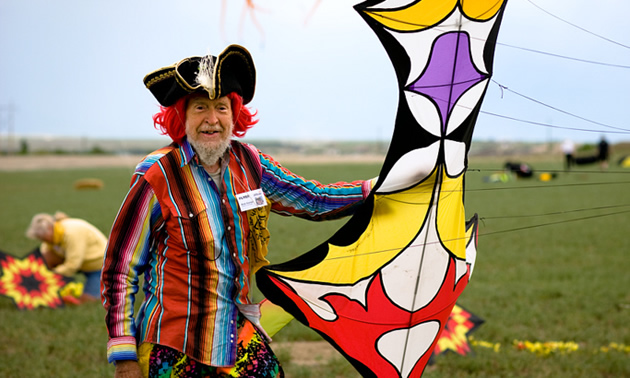Swift Current’s skies fill with colour during the annual Windscape Kite Festival
Kite flyers from all over the world love the open skies of Swift Current

Nearly 3,000 years ago the first kites took to the sky. Some believe it was a Chinese farmer who inadvertently discovered kite flying by tying a string to his hat to keep it from being taken away by the wind. Others say it was a result of the Chinese military using kites as surveillance tools. History does show that it was the Chinese who were responsible for kite flying’s continued popularity as a recreational pastime and for spreading a love of kites up and down its trade routes into other parts of Asia and Europe.
Still, it’s the simple pleasure of flying a kite that draws young and old alike, and it’s the challenge of keeping a kite aloft that has kept this activity alive and thriving throughout the world today, especially in parts of Asia and Europe, where the kiting tradition remains strong.
“They say every culture in the world has kites in their background,” said Shann Gowan, organizer of the annual Windscape Kite Festival held each June in her hometown of Swift Current, Saskatchewan. “In Asia and Europe they’ve continued with that tradition, while here in North America we’ve tended to let it go.”
That’s a situation Gowan has been hoping to remedy.
“In Europe they have these 10-day-long festivals with over 200,000 people in attendance,” said Gowan. “They’re simply huge. Ours is pretty small in comparison, but we’re growing each year.”
Gowan scours the globe looking for unique fliers to add to her roster of feature performers. This year she turned to some of Germany’s biggest kite-flying stars. Thanks in part to partnering with a sister festival in Saint Honore, Quebec, Windscape will host two German teams this year.
Both teams fly incredibly large kites that take not only tremendous talent to create but top skill to get airborne. Some kites are as large as 96 feet in length, and these giants of the skies are a colourful treat to the senses.
The two Canadian kite festivals are comparatively small in size and the kite culture of North America generally only offers kite-lovers 12 festivals a year. But for European fliers, the drawing card is something they don’t always get a chance to experience back home: wide open spaces and big skies to fly in.
“They don’t get that a lot in either Europe or Asia,” said Gowan. “Space is really at a premium there and they’re often relegated to flying on the beaches, so they really enjoy coming here to have the opportunity to take advantage of our space.”
A treat for both fliers and tourists alike, Windscape has become one of Swift Current’s biggest tourist attractions. Drawing upwards of 3,000 people its first few years, the festival now attracts over 6,000 visitors over two days. This year, Gowan said, she’s planning for at least 8,000 attendees.
With a whole range of family-friendly activities and entertainers, this free-admission festival also offers up kite-flying lessons and kite-building lessons. Even better, visitors get a two-for-one deal: while the days see the skies filled with kites, the nights feature the Long Day’s Night Music Festival, held to celebrate the longest night of the year. There are three different headlining musical acts and three opening acts on three successive evenings, all under the big top on the Windscape site.
In fact, the Long Days Night Music Festival in part prompted the start of Windscape, as Gowan, who organizes both festivals, couldn’t bear the thought of the large tent sitting idle during the days. So she took advantage of the popularity of a kite exhibit hosted by a local art gallery to start a kite festival. That decision has ended up making a significant contribution to the overall kite culture in North America.
Kite flying may have begun in China partly because essential building materials were so readily available there, namely bamboo for frames and silk for sails and ties. But Saskatchewan offers up the two other basic necessities to get kites up and flying--its forever-blowing warm summer winds and wide open spaces in which to fly. That combination is now building a kite culture all its own.
“We drive by the site of the festival every day as we head home,” said Gowan, “and now, even after the festival is long over, you can often see people out in the field just flying kites--and that’s really cool to see.”






